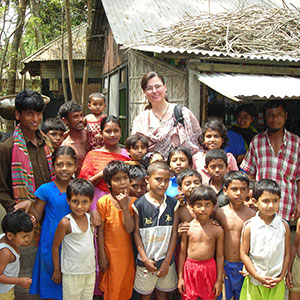For more than 10 years, Public Health Assistant Professor Molly Kile has traveled to Bangladesh to research the human health effects of arsenic exposure from drinking contaminated water.
“When I first started traveling to Bangladesh, my project was looking at arsenic exposure and cancer outcomes in an epidemiological study, and the first time I went I was hooked,” she says. “It was an opportunity to see the theory match up with the needs of the people in the communities, and the magnitude of the problem was just incredibly moving. It was an opportunity to really do public health on the front lines.”

Her mentor, David Christiani, who is also the principal investigator on the federally funded grants, first introduced Molly to the study of arsenic-related health effects.
“It was an opportunity that was funded at my old school, so I took it,” she says. “Little did I know that it was going to become a lifelong interest and passion.”
Arsenic is common in the ground water in Bangladesh. Unfortunately, this became known after people had switched from surface water to ground water to help reduce incidences of water borne disease.
“It really is a public health message that we need to take to heart, because this was completely preventable,” she says.
As an environmental epidemiologist, Molly’s concerned with examining chemicals in the environment that can be regulated. Her work entails identifying hazards in the environment, measuring how people are exposed to those hazards and conducting studies that help inform risk assessment in order to establish evidence-based policy and regulation regarding those hazards.
“Arsenic is a chemical and a known human carcinogen, but there’s much more work that needs to be done on non-cancer-related health outcomes,” she says. “That was a call by the National Academy of Sciences about 10 years ago, and we answered that call.”
Because Molly and her collaborators study basic human health risks associated with arsenic, their research efforts are funded by the National Institute of Environmental Health Sciences.
She travels to Bangladesh one or more times each year where she works closely with collaborators at Dhaka Community Hospital in Bangladesh.
Her role is to help design scientific studies, establish the methodology and travel to Bangladesh to train physicians and community healthcare workers at Dhaka Community Hospital to conduct the science.
“I first started doing just the arsenic exposure aspect, trying to figure out how people are being exposed to arsenic, how much was in the water, how much was in the food, and then trying to find good biomarkers in people so that we can do quantitative, molecular, epidemiological studies,” she says.
That work then grew into more complicated studies that looked at reproductive health outcomes and the effects of arsenic on both the mother and their children.
Since then, different research projects have followed those children while they age, looking at their neurodevelopmental assessments. This work, led by Harvard School of Public Health where Molly was a research associate prior to coming to Oregon State in 2011, involves collaboration with Oregon State University and Dhaka Community Hospital.
“Our research has also grown into examining some of the epigenetic effects of in utero arsenic exposure, which is some of the work that I’ve been leading,” she says. “We’re always looking for additional opportunities to do other studies that are needed both in Bangladesh and that inform arsenic-related health research.”
While in Bangladesh, Molly spends time walking through villages affected by arsenic poisoning.
“When I do, I see people who have the skin lesions, and they come and talk to me and they express their concerns and their willingness to participate in research because they want to understand what the health effects are, and they help want to contribute to a greater understanding of science,” she says. “The people of Bangladesh are my inspiration. They’re the ones who are affected and yet are so generous in participating in our studies.”
Molly’s goal is for her research to provide the evidence needed to make sound, environmental health decisions.
“I hope that my research informs the drinking water standards so that we truly are protective of all the population, including unborn children,” she says.
She also believes it’s important to share the lessons she’s learned in Bangladesh with her students at Oregon State.
“It really doesn’t get more real,” she says. “Students are very interested in doing water-related health studies, and they tend to focus all on the infectious diseases. That’s what’s got us into the problem in Bangladesh. People only looked at the infectious diseases and they never tested the water for arsenic, so it really is an example of the need for people who want to do international health to look at the whole problem before they start to do interventions. The arsenic crisis in Bangladesh was completely preventable if people had done their homework.”



One reply on “Video: On the front lines of public health”
[…] Bringing it home: PHHS researcher shares her aha! moment […]